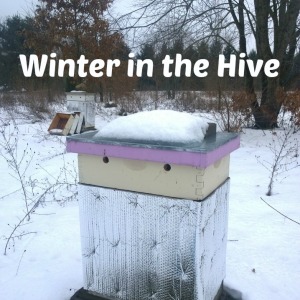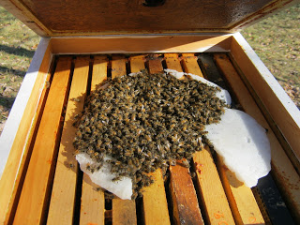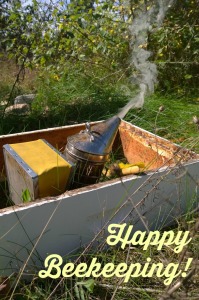Man, beekeeping is an emotional roller coaster. Two years ago, our three hives survived the mild, Michigan winter like champs. My husband and I did everything the books told us to do and it was a success! We were feeling pretty darn proud of ourselves. Then last winter hit: record cold, record snow, wind gusts that, I swear, blew straight through the house. It was a nasty one. Now this year, we seem to be back into the mild category once again (although all true Michiganders know it’s way too early to make bets!).
Last year provided the opportunity for my husband and I to lay awake in bed, night after night, listening to the screaming wind and wonder, “Can the bees survive this?” Then when we looked out in the morning and saw snow drifted over the hives we wondered, “Can the bees survive that?” Then when the weather forecasters said, “We’re looking at record cold temperatures for the third day in a row.” We worried, “There’s no way they’ll survive that.” Well, it turned out they did not survive these things. In fact, roughly a quarter of the beekeepers who responded to the Bee Informed spring survey reported colony losses as well. If you were to eavesdrop on conversations around the 2014 Bee School put on by the Kalamazoo Bee Club, most of what you’d have heard would have been beekeepers lamenting the loss of their hives!
It feels like all we can do as beekeepers in the winter is sit inside our warm houses with a cup of coffee in hand, peer through the blinds, and hope everything is going okay in there. So I’ve offered a very basic explanation as to just how those bees do survive the winter. I realize that this topic could warrant a novel-sized discussion, but for the sake of brevity, just the basics…

Bumblebees and wasps, for example, go dormant, but honeybees actually need to keep themselves alive all winter. So basically, they spend the winter staying warm, and therefore, alive. This requires constant vibration of their wings and a food supply (ideally, honey) to munch on.
At the onset of winter, the worker bees force the drone bees out of the hive. The drones will basically starve to death and die. Harsh, I know. It’s important, however, to whittle the colony down to “just the necessities” in order to survive. The queen stops laying (temporarily) and everyone hunkers down around the honey. My favorite detail about bees in winter is the ball, or cluster, they form to keep everyone warm and fed. Here’s a great description from about.com:
The honey bee workers form a cluster around the queen and brood, keeping them warm. They keep their heads pointed inward. Bees on the inside of the cluster can feed on the stored honey. The outer layer of workers insulates their sisters inside the sphere of honey bees. As ambient temperatures rise, the bees on the outside of the group separate a bit, to allow more air flow. As temperatures fall, the cluster tightens, and the outer workers pull together.
Here’s an overhead view of a winter cluster from Stevens Bees. In this photo they are clustered around some fondant.
Last spring when we were finally able to get into our hives, we found all the bees dead. That was devastating, but we were able to do some cool analysis of the hive. Here’s a picture of the dead bees still in cluster-form. You can imagine if the frames were put back together inside the hive how it would form a ball-shape.
So this is what winter looks like in a hive. The honey provides the necessary energy to keep them alive. The bees vibrate their wings (or shiver, if you will) to stay warm and with all these little bee bodies vibrating at one time, in one big cluster, I’ve read the hive temperature can exceed 80 degrees. Nice and toasty, I’d say. Another detail I love is that, as the bees on the outside of the cluster start to feel chilled or hungry, they shove their way into the center of the cluster to warm up and new bees take their turns on the outside. Smart little buggers, I mean, bugs.
If you’d like a wonderful, detailed analysis of the cluster and how it works, you should read THIS post from Brookfield Farm.
As you may remember from my last post, our bees didn’t make enough honey this year and so, we are feeding (which, on the positive side, gives us something to DO during the winter!). We’re trying the Mountain Camp Method this year and I’m planning to explain that next month.



What were the findings of why your hives didn’t survive?